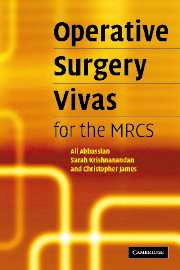Book contents
- Frontmatter
- Contents
- Preface
- 1 The elective repair of an abdominal aortic aneurysm
- 2 Adrenalectomy
- 3 Amputation (below knee)
- 4 Anorectal abscesses, fistulae and pilonidal sinus
- 5 Appendicectomy
- 6 Principles of bowel anastomosis
- 7 Breast surgery
- 8 Carotid endarterectomy
- 9 Carpal tunnel decompression
- 10 Central venous cannulation
- 11 Cholecystectomy (laparoscopic)
- 12 Circumcision
- 13 Colles' fracture (closed reduction of)
- 14 Compound fractures
- 15 Dupuytren's contracture release
- 16 Dynamic hip screw
- 17 Fasciotomy for compartment syndrome
- 18 Femoral embolectomy
- 19 Femoral hernia repair
- 20 Haemorrhoidectomy
- 21 Hip surgery
- 22 Hydrocele repair
- 23 The open repair of an inguinal hernia
- 24 Laparotomy and abdominal incisions
- 25 Oesophago-gastroduodenoscopy
- 26 Orchidectomy
- 27 Parotidectomy
- 28 Perforated peptic ulcer
- 29 Pyloric stenosis and Ramstedt's pyloromyotomy
- 30 Right hemicolectomy
- 31 Skin cover (the reconstructive ladder)
- 32 Spinal procedures
- 33 Splenectomy
- 34 Stomas
- 35 Submandibular gland excision
- 36 Tendon repairs
- 37 Thoracostomy (insertion of a chest drain)
- 38 Thoracotomy
- 39 Thyroidectomy
- 40 Tracheostomy
- 41 Urinary retention and related surgical procedures
- 42 Varicose vein surgery
- 43 Vasectomy
- 44 Zadik's procedure
39 - Thyroidectomy
Published online by Cambridge University Press: 16 October 2009
- Frontmatter
- Contents
- Preface
- 1 The elective repair of an abdominal aortic aneurysm
- 2 Adrenalectomy
- 3 Amputation (below knee)
- 4 Anorectal abscesses, fistulae and pilonidal sinus
- 5 Appendicectomy
- 6 Principles of bowel anastomosis
- 7 Breast surgery
- 8 Carotid endarterectomy
- 9 Carpal tunnel decompression
- 10 Central venous cannulation
- 11 Cholecystectomy (laparoscopic)
- 12 Circumcision
- 13 Colles' fracture (closed reduction of)
- 14 Compound fractures
- 15 Dupuytren's contracture release
- 16 Dynamic hip screw
- 17 Fasciotomy for compartment syndrome
- 18 Femoral embolectomy
- 19 Femoral hernia repair
- 20 Haemorrhoidectomy
- 21 Hip surgery
- 22 Hydrocele repair
- 23 The open repair of an inguinal hernia
- 24 Laparotomy and abdominal incisions
- 25 Oesophago-gastroduodenoscopy
- 26 Orchidectomy
- 27 Parotidectomy
- 28 Perforated peptic ulcer
- 29 Pyloric stenosis and Ramstedt's pyloromyotomy
- 30 Right hemicolectomy
- 31 Skin cover (the reconstructive ladder)
- 32 Spinal procedures
- 33 Splenectomy
- 34 Stomas
- 35 Submandibular gland excision
- 36 Tendon repairs
- 37 Thoracostomy (insertion of a chest drain)
- 38 Thoracotomy
- 39 Thyroidectomy
- 40 Tracheostomy
- 41 Urinary retention and related surgical procedures
- 42 Varicose vein surgery
- 43 Vasectomy
- 44 Zadik's procedure
Summary
What is the arterial and venous supply to the thyroid gland?
Arterial supply Superior and inferior thyroid arteries on both sides. The superior thyroid artery is a branch of the external carotid and the inferior thyroid artery is a branch of the thyrocervical trunk, which in turn is a branch of the subclavian artery. At times the single thyroid ima artery, which is a direct branch of the brachiocephalic trunk, may be present in the midline.
Venous supply This is via the superior, middle and inferior thyroid veins on both sides. The former two drain into the internal jugular veins whereas the inferior thyroid veins drain into the brachiocephalic veins.
What specific pre-operative measures are taken prior to a thyroidectomy for thyrotoxicosis?
Patients must be made euthyroid
Vocal cord assessment using indirect laryngoscopy
Biochemical analysis of calcium metabolism pre-operatively
β-blockers may also be considered in an unstable patient
In large retro-sternal goitres a CT scan is performed to assess tracheal deviation and the extent of retro-sternal extension
Iodine for 2 weeks pre-operatively can reduce the vascularity of the gland
What different types of thyroidectomy do you know?
Hemithyroidectomy (lobectomy or isthmusectomy)
Total thyroidectomy (subtotal, near total or total)
What is a subtotal thyroidectomy?
Subtotal thyroidectomy refers to the excision of the entire gland but leaving about 4 g of thyroid tissue on each side. It is thought that this will reduce the risk of damage to the recurrent laryngeal nerves as well as protecting the parathyroids. There is also enough thyroid tissue left behind to avoid post-operative thyroid hormone replacement.
- Type
- Chapter
- Information
- Operative Surgery Vivas for the MRCS , pp. 145 - 148Publisher: Cambridge University PressPrint publication year: 2006



